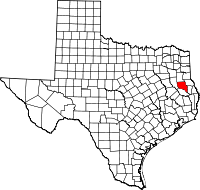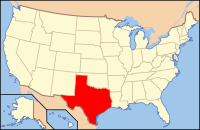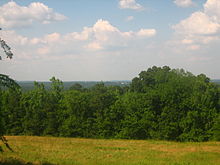- Nacogdoches County, Texas
-
Nacogdoches County, Texas 
Location in the state of Texas
Texas's location in the U.S.Founded 1836 Seat Nacogdoches Area
- Total
- Land
- Water
981 sq mi (2,541 km²)
947 sq mi (2,453 km²)
35 sq mi (91 km²), 3.52%Population
- (2010)
- Density
64,524
67.7/sq mi (26.1/km²)Website www.co.nacogdoches.tx.us Nacogdoches County (
 /ˌnækəˈdoʊtʃɨs/) is a county located in the U.S. state of Texas. In 2000, its population was 59,203. Its county seat is Nacogdoches[1]. The Nacogdoches Micropolitan Statistical Area includes all of Nacogdoches County.
/ˌnækəˈdoʊtʃɨs/) is a county located in the U.S. state of Texas. In 2000, its population was 59,203. Its county seat is Nacogdoches[1]. The Nacogdoches Micropolitan Statistical Area includes all of Nacogdoches County.Nacogdoches hosts the Blueberry Festival the second Saturday in June. The county is the top blueberry producer in Texas and is headquarters for the Texas Blueberry Marketing Association. It recently tagged itself as the "Capital of the Texas Forest Country". The county is one of the first Texas Certified Retirement Communities.
Nacogdoches County is represented in the Texas House of Representatives by the conservative Republican Wayne Christian, a financial analyst from Center in nearby Shelby County.
Contents
Notable residents
- The Nacogdoches merchant and civic leader Carl Edwin Monk, Sr., was known as "Mr. Highways". The scenic area off State Highway 7 east of Nacogdoches bears his name.
- Clint Dempsey, professional soccer player
- Ron Raines, actor
- John H. Hannah, Jr. - U.S. District Court judge
Geography
According to the U.S. Census Bureau, the county has a total area of 981 square miles (2,540 km2), of which 947 square miles (2,450 km2) is land and 35 square miles (91 km2) (3.52%) is water.
Major Highways
Adjacent counties
- Rusk County (north)
- Shelby County (northeast)
- San Augustine County (southeast)
- Angelina County (south)
- Cherokee County (west)
National protected area
- Angelina National Forest (part)
Demographics
Historical populations Census Pop. %± 1850 5,193 — 1860 8,292 59.7% 1870 9,614 15.9% 1880 11,590 20.6% 1890 15,984 37.9% 1900 24,663 54.3% 1910 27,406 11.1% 1920 28,457 3.8% 1930 30,290 6.4% 1940 35,392 16.8% 1950 30,326 −14.3% 1960 28,046 −7.5% 1970 36,362 29.7% 1980 46,786 28.7% 1990 54,753 17.0% 2000 59,203 8.1% 2010 64,524 9.0% U.S. Census Bureau[2] Texas Almanac[3] As of the census[4] of 2000, there were 59,203 people, 22,006 households, and 14,039 families residing in the county. The population density was 62 people per square mile (24/km²). There were 25,051 housing units at an average density of 26 per square mile (10/km²). The racial makeup of the county was 75.00% White, 16.74% Black or African American, 0.39% Native American, 0.70% Asian, 0.07% Pacific Islander, 5.70% from other races, and 1.41% from two or more races. 11.25% of the population were Hispanic or Latino of any race.
There were 22,006 households out of which 30.50% had children under the age of 18 living with them, 48.30% were married couples living together, 11.80% had a female householder with no husband present, and 36.20% were non-families. 27.60% of all households were made up of individuals and 9.30% had someone living alone who was 65 years of age or older. The average household size was 2.49 and the average family size was 3.08.
In the county, the population was spread out with 24.00% under the age of 18, 20.00% from 18 to 24, 24.70% from 25 to 44, 19.20% from 45 to 64, and 12.10% who were 65 years of age or older. The median age was 30 years. For every 100 females there were 93.00 males. For every 100 females age 18 and over, there were 89.00 males.
The median income for a household in the county was $28,301, and the median income for a family was $38,347. Males had a median income of $29,502 versus $21,422 for females. The per capita income for the county was $15,437. About 15.50% of families and 23.30% of the population were below the poverty line, including 27.10% of those under age 18 and 13.90% of those age 65 or over.
According to the US Census Bureau's 2008 estimate,[5] the population of Nacogdoches County had risen to 62,768, a 6.02% increase over the official 2000 United States Census.
Cities and towns
- Appleby
- Central Heights (unincorporated)
- Chireno
- Cushing
- Douglass
- Etoile (unincorporated)
- Garrison
- Kingtown (unincorporated)
- Lilbert (unincorporated)
- Martinsville (unincorporated)
- Melrose
- Nacogdoches
- Sacul (unincorporated)
- Trawick
- Woden (unincorporated)
Transportation
The TTC-69 component (recommended preferred) of the planned Trans-Texas Corridor goes through Nacogdoches County.[6][7]
See also
References
- ^ "Find a County". National Association of Counties. http://www.naco.org/Counties/Pages/FindACounty.aspx. Retrieved 2011-06-07.
- ^ http://www.factfinder.census.gov
- ^ http://www.texasalmanac.com/population/population-counties-history.pdf
- ^ "American FactFinder". United States Census Bureau. http://factfinder.census.gov. Retrieved 2008-01-31.
- ^ http://www.census.gov/popest/counties/
- ^ TxDoT, TTC Section D, Detailed Map 1, 2007-12-19
- ^ TxDoT, TTC Section E, Detailed Maps 2 (2007-12-21) & 4 (2008-01-24)
External links
- Nacogdoches County government's website
- Nacogdoches County Chamber of Commerce website
- Nacogdoches County from the Handbook of Texas Online
- Interactive Community website
- Texas Blueberry Festival website

Rusk County Shelby County 
Cherokee County 
 Nacogdoches County, Texas
Nacogdoches County, Texas 

Angelina County San Augustine County Municipalities and communities of Nacogdoches County, Texas Cities Appleby | Chireno | Cushing | Garrison | Nacogdoches
Unincorporated
communitiesCentral Heights | Douglass | Etoile | Kingtown | Lilbert | Martinsville | Melrose | Sacul | Trawick | Woden
Categories:- Texas counties
- Nacogdoches County, Texas
- 1836 establishments in the United States
- Populated places established in 1836
Wikimedia Foundation. 2010.


